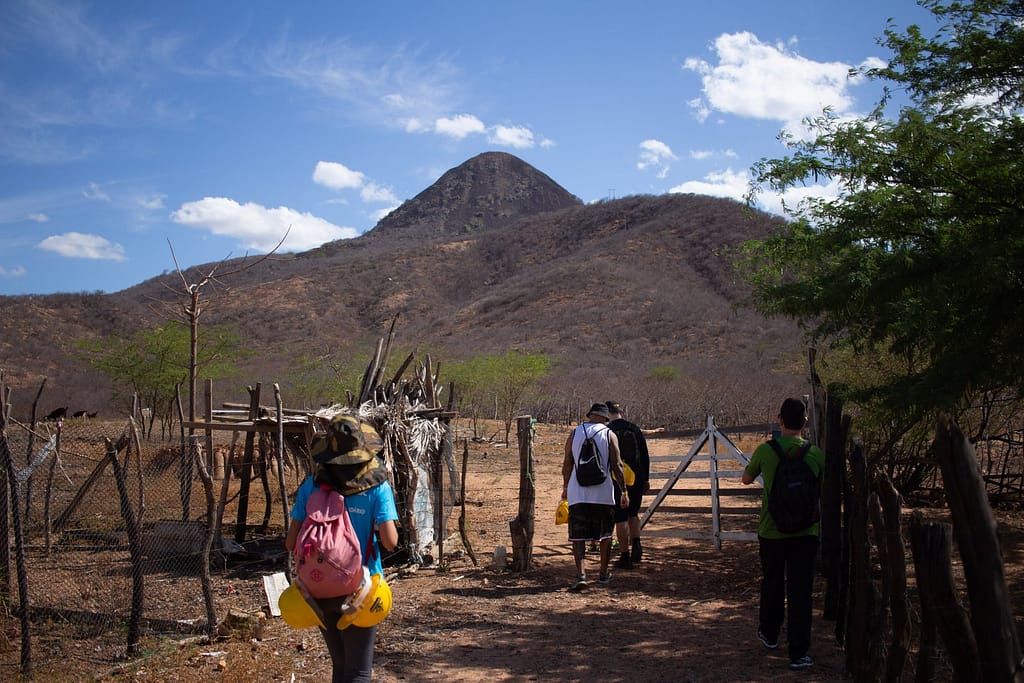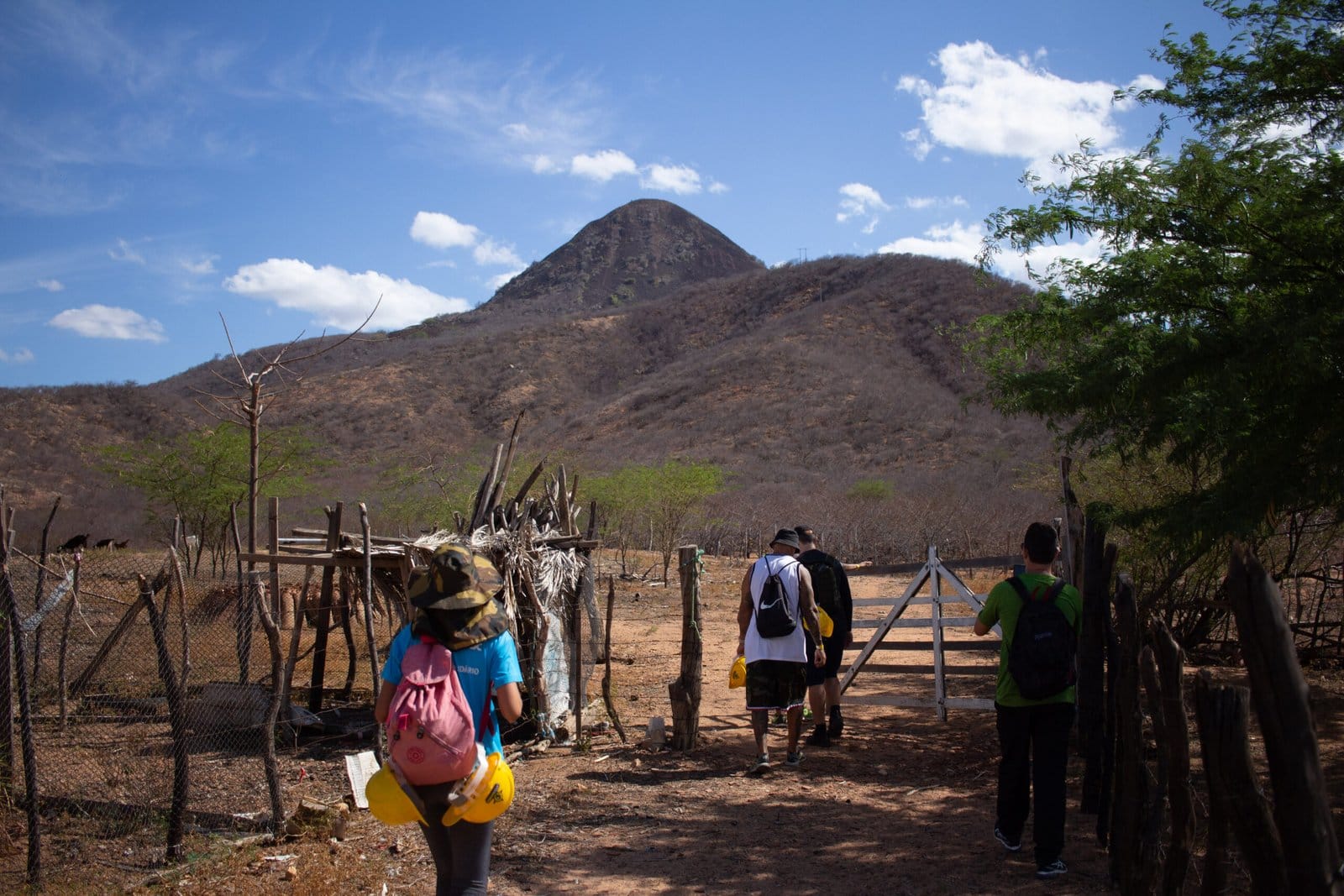Located in the caatinga region, Pico do Cabugi is a true natural and historical treasure in Rio Grande do Norte, Brazil.
With its impressive volcanic formation and breathtaking landscapes, it attracts adventurers, nature lovers, and curious visitors in search of a unique experience.
In this complete guide, we’ll explore everything you need to know about Cabugi Peak: how to get there, where to stay, the best times to visit, and more.
Get ready to discover the trails, abundant wildlife, local culture, and fascinating history of this remarkable place.

Travel Guide to Pico do Cabugi
To reach Cabugi Peak, there are different routes and transportation options available. The most common way is via Natal’s International Airport, located approximately 160 km away.
From the airport, you can rent a car and follow the BR-304 highway to the town of Angicos, which serves as the main base for exploring Cabugi Peak. Alternatively, you can take a bus, with regular lines departing from Natal to Angicos.
Be sure to create an itinerary that includes other attractions in Rio Grande do Norte—a small state in size but rich in spectacular destinations!
Discover here all about Pipa Beach in Rio Grande do Norte!
In the Cabugi Peak region, you’ll find various accommodation options. In Angicos, there are simple inns that provide comfort and convenience to visitors. Additionally, you can find campgrounds and more budget-friendly options for those who prefer staying closer to nature.

The best time to visit Cabugi Peak is during the dry season, from June to December, when there’s a lower chance of rain. This period provides more favorable conditions to explore the trails and enjoy the panoramic views from the peak.
However, it’s essential to keep in mind that temperatures can be high during the day, so it’s recommended to bring sunscreen and stay well-hydrated.
There are various trails to explore around Pico do Cabugi. The most popular one leads to the top, offering an incredible panoramic view of the region. The trail is of moderate difficulty and takes around 2 hours to complete, with some steep sections.

As you make your way up, you’ll have the opportunity to appreciate the rich biodiversity of the Caatinga and marvel at the unique rock formations.
Along the trail, there are points of interest, such as Pedra do Anjo (Angel Rock), which offers a stunning view and holds cultural significance for the region. It’s important to follow marked paths and guidelines to ensure safety throughout your hike.
When visiting Cabugi Peak, following some safety tips can make for a more enjoyable and secure experience.
It’s recommended to hike with an experienced local guide who knows the area well and can share relevant insights along the way. Be sure to wear comfortable footwear and bring water and snacks to stay hydrated and nourished on the trail.
Also, remember to respect nature by leaving no trash behind and following preservation guidelines for the site.

If you enjoy camping and are looking for a closer experience with nature, you’ll be pleased to know that you can spend the night at Pico do Cabugi! Before heading out, it’s essential to be well-prepared.
Make sure to bring a sturdy tent, a suitable sleeping bag, flashlights, non-perishable food, and enough water.
Choose a safe spot to set up your tent, away from steep slopes, with a privileged view. Remember to follow environmental preservation guidelines, packing out all your trash and respecting the local flora and fauna.
Enjoy the starry night and immerse yourself in a unique experience amidst the stunning nature of Cabugi Peak.
If you’re planning to hike Pico do Cabugi, travel insurance is essential. This extinct volcano offers stunning views and adventurous trails, but outdoor activities always come with a few risks.
Having travel insurance means you’re protected in case of accidents, health issues, or unexpected changes to your trip. You can buy your plan through our affiliate link, it costs you nothing extra and helps support Do in Brazil so we can keep creating authentic, helpful travel guides for exploring Brazil safely.
The Historical Importance of Pico do Cabuji: A Cultural and Geological Landmark
Cabugi Peak holds historical significance that goes beyond its impressive geological structure. Over the years, this remarkable landmark has played an essential role in Brazil’s historical and cultural events.
It is believed that the peak served as a navigational guide during the Age of Discovery, used as a geographic reference for exploring Brazil’s coastline due to its long-range visibility and distinctive shape.
Additionally, Cabugi Peak is steeped in local myths and legends that reflect the ancestral origins and rich culture of the region.
Its majestic and historical presence is a powerful reminder of the connection between nature, history, and culture, making Cabugi Peak an unmissable destination for those eager to explore Brazil’s historical richness.

My Ascent of Pico do Cabugi
Nel and I took a day trip from Natal to explore Cabugi Peak. We left early with the group Capitão Amarelo, adventure tourism agency from Rio Grande do Norte, and arrived in Angicos by morning.
Our journey began at Serra do Feiticeiro (Wizard’s Ridge), where there’s a small chapel dedicated to a boy who got lost in the area.

The place where his body was found is called Pedra do Anjo (Angel’s Rock). A bit further along, there’s a lookout point with a view of our next goal: Cabugi Peak.
Before tackling the ascent, we stopped for lunch at Fazenda Boa Vista (Good View Farm), which hosts adventurers wanting to climb Cabugi Peak or camp nearby. The meal was hearty and regional, showcasing the flavors of the northeastern backlands.
After a rest, we began the climb. Cabugi means “maiden’s breast” in Tupi – an indigenous language historically spoken by the Tupi Guarani people in Brazil – named for its shape. It’s a volcano that never erupted, preserving its original form.
The climb is challenging, especially with the intense heat of the backlands. The terrain is unstable, with loose rocks that heat up significantly in the sun. Much of the ascent involves rock scrambling, so we wore helmets for protection.
We reached the peak close to sunset, making the atmosphere much cooler and enjoyable at the summit. Standing 590 meters high, you can see the wind turbines along the coast.
Another amazing experience to add to the list! The sunset was beautiful, and the sense of accomplishment from overcoming this challenge was unbeatable.

The Pico do Cabugi is a destination that blends adventure, lush nature, and a fascinating history. Whether you’re an adventurer looking for challenging trails, a photography enthusiast, or someone interested in local culture, Pico do Cabugi will surely offer a memorable experience.
Explore the hike, marvel at the biodiversity, absorb the unique energy of this place, and discover why it’s so special. Get ready for an unforgettable journey to the heart of the Brazilian caatinga!
Read about another adventure between the states of Rio Grande do Norte and Paraíba: Pedra da Boca!





Pingback: Natal: Everything You Need to Know About What to Do in the Capital of Rio Grande do Norte, Brazil! - Do in Brazil